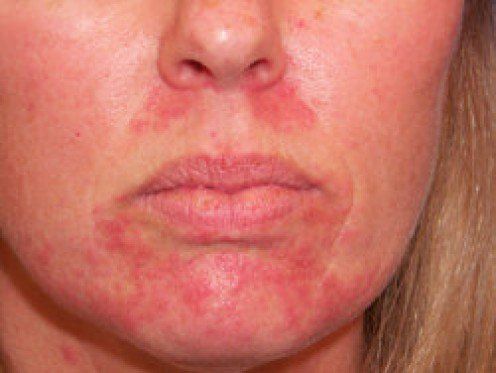A rash on the face is a distressing condition for most people as it can be cosmetically challenging. The rash may manifest, accompanied with itching, blistering, bleeding, redness, scaling, swelling, and dry skin. The appearance of the facial rash may vary in appearance, location and severity according to its underlying cause. For instance, it can be red, white, purple or silver in color. The texture of the rash too can vary as being bumpy, scaly, smooth or raised. Also what to note is whether the rash affects a small area in the face or spreads across a large area. Facial rashes can be caused by a number of conditions that range from mild to extremely serious. This article will help you identify the possible causes of rashes on face as well as become educated on available treatment for the condition.

The Causes of Rash on Face
The appearance of the facial rash and its symptoms depend on its cause. Below is a list of the most probable causes of face rashes.
- Psoriasis – This condition affects more than 46% of the world population. The most common symptoms of psoriasis are itchy rashes, silvery scales and sometimes, open lesions. Psoriasis of the face affects areas such as the skin above the upper lip, areas around the forehead and eyebrows and near the hairline.
- Allergy – Itchiness and redness of the face is often a cause of an allergic reaction to either foods or a facial product. An allergic reaction to strawberries or shellfish, for example, may result in a rash on face. It can also occur due to the use of expired facial products. A product you have used previously without any problem can cause an allergic reaction when being used another time.
- Dry Skin – Dry skin causes the facial skin to appear dry and itch. Untreated dry skin can lead to psoriasis. Lack of oils and extreme fat intake in the diet is a common cause of dry skin on the face. It can also occur due to inferior facial products and the application of hard and harsh soaps. Dry skin on the face can also occur due to more serious conditions, such as, diabetes and hypothyroidism.
- Heat Rash – Overexposure to heat and sunlight may result in a heat rash. Red clusters of pimples on the face and neck are common symptoms of a heat rash. This is the body's way of warning the person that he/she is exposed to excessive heat or sunlight and may suffer from a heat stroke or exhaustion.
How to Treat Rash on Face
Facial rashes can be annoying primarily because it can affect the facial appearance. The treatment of a facial rash will depend on the severity and underlying cause. There are several natural remedies that provide relief and cure the rash, although more serious cases of facial rashes require over-the-counter medications or prescription medical intervention.
Natural remedies for treating rash on the face include:
- The application of a mixture of olive oil and baking soda or Aloe Vera to relieve itching
- Vitamin E and cod liver oil for curing a rash
- The application of an ice pack to relieve itching of the face from an allergy
- Cooked oatmeal for pain relief from extreme itching
- Calcium gluconate and water for rash relief
Certain steps and practices as well as remedies that can help avoid or treat facial rashes include the following:
- Psoriasis of the face can be treated by keeping the skin moist, avoiding hot water, getting sunlight and stopping smoking. Petroleum jelly or moisturizers and topical applications can also be considered, if natural remedies do not work in curing the symptoms of psoriasis.
- Allergy rashes can be prevented by avoiding the exposure to the allergy trigger and stopping the use of harsh facial products.
- Dry skin on the face can be prevented by avoiding washing the face often with harsh soaps and inferior products, and by switching to a balanced diet.
- Heat rash does not require treatment, although cooling down may be beneficial for avoiding exhaustion.
In situations where above remedies are not effective in curing the rash, topical creams may be prescribed by a doctor. Most of these medications will be anti-allergy medications. Topical steroids are categorized under 7 groupings based on potency and below are a list of the most common medications grouped accordingly. Group 7 medications are least potent and appropriate for mild conditions while group 1 medications will be prescribed for a severe case of contact dermatitis.
Topical steroids are typically classified into 7 groups on the basis of potency level, with group 1 being the strongest and group 7 being the weakest. The following are examples of commonly used topical steroids from each group:
- Group 1 - Clobetasol and betamethasone cream or ointment
- Group 2 - Fluocinonide and desoximetasone 0.25% cream Elocon ointment
- Group 3 - Topicort 0.05% cream, Cutivate ointment
- Group 4 - hydrocortisone valerate and triamcinolone 0.1% and mometasone furoate
- Group 5 - Propionate, Westcort cream
- Group 6 - Desonide) cream
- Group 7 - Hydrocortisone acetate
When treating children, the doctors will recommend milder forms of topical applications and currently, Cutivate (fluticasone propionate) and Elocon (mometasone furoate) are deemed to be safer for kids according to recently published results. Cutivate is also the only FDA approved topical steroid for infants of 3 month age range.
